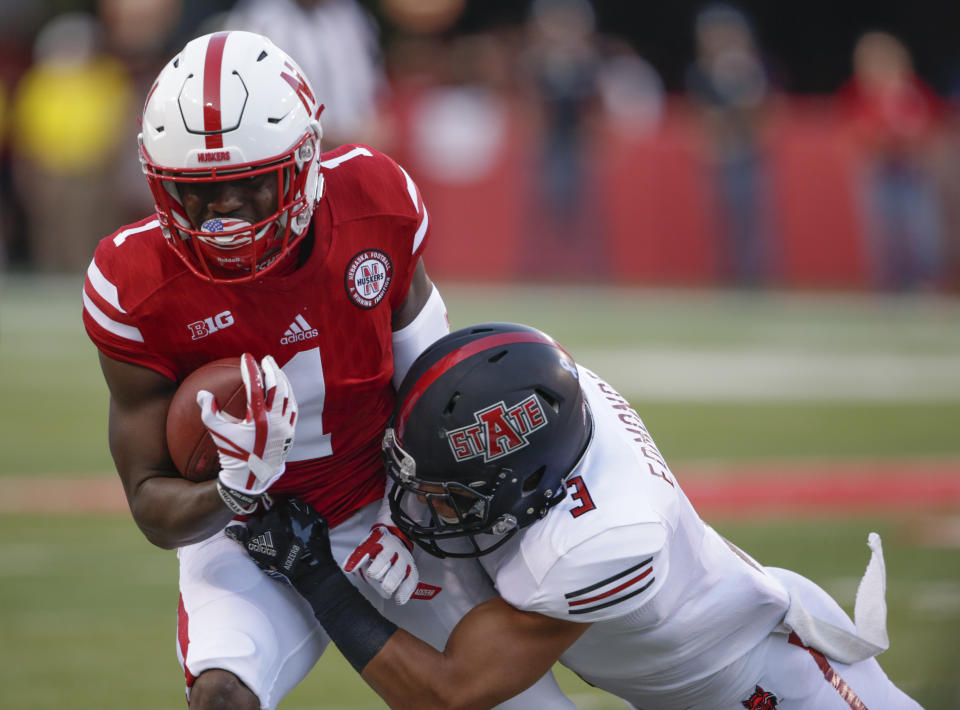2 Nebraska players hospitalized after winter workout

Two Nebraska players were hospitalized after strenuous winter workouts.
New Huskers coach Scott Frost confirmed to the Lincoln Journal Star that wide receiver Tyjon Lindsey and defensive lineman Dylan Owen were both treated for rhabdomyolysis after a workout last week. Lindsey was in the hospital for three days. Owen’s hospital stay was two days. The two were both released this week and are back with the team, Frost said.
“Anything that happens in our program is ultimately my responsibility,” Frost told the Journal Star. “Our strength coach and training room were coordinating to do absolutely the best they could to make sure the transition went smooth, but two kids that exerted themselves too far and had (rhabdomyolysis).
“I want to make sure people understand that the health of our players is always going to be our primary concern. It’s been kind of a scary deal and both kids are doing fine now.”
The NCAA sports medicine handbook describes rhabdomyolysis as “breakdown of skeletal muscle” that “connotes an acute clinical syndrome of major muscle breakdown and leakage into the bloodstream of muscle contents.” Exercise is listed as one of the causes.
Exertional rhabdomyolysis occurs in the setting of strenuous exercise and can range from mild to severe. Clinical signs are often nonspecific: muscle pain, soreness, stiffness, and, in severe cases, weakness, loss of mobility, and swollen, tender muscles. Severe ER is far more problematic than the milder form known as delayed onset muscle soreness (DOMS), in which muscles become sore and stiff in the first few days after a bout of unaccustomed, moderately strenuous exercise. DOMS is rarely a clinical problem and tends to be self-limited with only relative rest or a cutback in level of training.
Severe ER is a major health concern for any athlete. A challenge to the early recognition of ER for the athlete and clinician is that signs and symptoms of it during the triggering bout of intense exercise can be few and subtle. But there are clues that coaches and athletic trainers can watch for outlined by case examples involving team outbreaks. Importantly, signs and symptoms of severe ER can begin in the first few hours after the triggering exercise bout and tend to peak over the subsequent two days.
Frost, in his first season as head coach at his alma mater after two years at Central Florida, said the weightlifting workout that caused the problem was actually modified — cut down from 40 to 32 minutes — based on testing the strength staff conducted on the players. Frost said the two players showed the early symptoms of rhabdo, so campus medical staff thought it was best to take them to the hospital.
“The workout that caused the problem was supposed to be a 40-minute weight workout and it was cut to 32 minutes of weights,” Frost said. “It’s fairly intense, but it’s something that we did with our team for two years at UCF. I’m not trying to make an excuse, but I’m always going to be transparent. We had trainers in the weight room during the workout to pull guys out of the workout if they saw any problems. Despite all that, we still had two kids that ended up having problems. Our players are our No. 1 concern. We thought we were approaching everything safely and the right way and it turns out that it was a little too much for a couple of them.”
This is the second offseason in a row a major program — with a new coaching staff — had players diagnosed with rhabdomyolysis. Last January, three Oregon players were hospitalized with rhabdo after a workout under the strength staff hired by-then head coach Willie Taggart. Taggart, who was hired away from South Florida and left Oregon after a year for the Florida State job, issued an apology and suspended strength coach Irele Oderinde for a month without pay.
Previously, in 2011, 13 Iowa players were hospitalized with rhabdomyolysis after winter workouts. One of those players, cornerback William Lowe, sued the school, saying the workouts caused lasting harm. He and the university reached a $15,000 settlement in 2016.
– – – – – – –
Sam Cooper is a writer for Yahoo Sports. Have a tip? Email him or follow him on Twitter!

